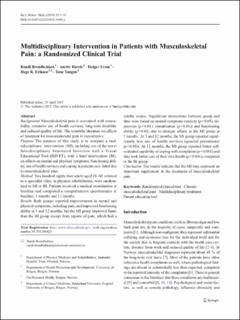| dc.contributor.author | Brendbekken, Randi | |
| dc.contributor.author | Harris, Anette | |
| dc.contributor.author | Ursin, Holger | |
| dc.contributor.author | Eriksen, Hege R. | |
| dc.contributor.author | Tangen, Tone | |
| dc.coverage.spatial | Norway | en_US |
| dc.date.accessioned | 2020-03-12T10:44:13Z | |
| dc.date.available | 2020-03-12T10:44:13Z | |
| dc.date.issued | 2016 | |
| dc.identifier.citation | Int J Behav Med. 2016 Feb;23(1):1-11. doi: 10.1007/s12529-015-9486-y. | en_US |
| dc.identifier.issn | 1070-5503 | |
| dc.identifier.uri | https://hdl.handle.net/11250/2646527 | |
| dc.description.abstract | Abstract
BACKGROUND:
Musculoskeletal pain is associated with comorbidity, extensive use of health services, long-term disability and reduced quality of life. The scientific literature on effects of treatment for musculoskeletal pain is inconclusive.
PURPOSE:
The purpose of this study is to compare a multidisciplinary intervention (MI), including use of the novel Interdisciplinary Structured Interview with a Visual Educational Tool (ISIVET), with a brief intervention (BI), on effects on mental and physical symptoms, functioning ability, use of health services and coping in patients sick-listed due to musculoskeletal pain.
METHOD:
Two hundred eighty-four adults aged 18-60, referred to a specialist clinic in physical rehabilitation, were randomized to MI or BI. Patients received a medical examination at baseline and completed a comprehensive questionnaire at baseline, 3 months and 12 months.
RESULTS:
Both groups reported improvements in mental and physical symptoms, including pain, and improved functioning ability at 3 and 12 months, but the MI group improved faster than the BI group except from reports of pain, which had a similar course. Significant interactions between group and time were found on mental symptoms (anxiety (p < 0.05), depression (p < 0.01), somatization (p < 0.01)) and functioning ability (p < 0.01) due to stronger effects in the MI group at 3 months. At 3 and 12 months, the MI group reported significantly less use of health services (general practitioner (p < 0.05)). At 12 months, the MI group reported better self-evaluated capability of coping with complaints (p < 0.001) and they took better care of their own health (p < 0.001), compared to the BI group.
CONCLUSION:
The results indicate that the MI may represent an important supplement in the treatment of musculoskeletal pain. | en_US |
| dc.description.sponsorship | Innlandet Hospital Trust (Norway) funded the study. | en_US |
| dc.language.iso | eng | en_US |
| dc.publisher | Springer Link | en_US |
| dc.rights | Navngivelse 4.0 Internasjonal | * |
| dc.rights.uri | http://creativecommons.org/licenses/by/4.0/deed.no | * |
| dc.subject | Chronic musculoskeletal pain; | en_US |
| dc.subject | Multidisciplinary treatment; | en_US |
| dc.subject | Patient education tool; | en_US |
| dc.subject | Randomized clinical trial | en_US |
| dc.title | Multidisciplinary Intervention in Patients with Musculoskeletal Pain: a Randomized Clinical Trial | en_US |
| dc.type | Peer reviewed | en_US |
| dc.type | Journal article | en_US |
| dc.description.version | publishedVersion | en_US |
| dc.rights.holder | This article is distributed under the terms of the
Creative Commons Attribution 4.0 International License (http://
creativecommons.org/licenses/by/4.0/), which permits unrestricted
use, distribution, and reproduction in any medium, provided you
give appropriate credit to the original author(s) and the source,
provide a link to the Creative Commons license, and indicate if
changes were made. | en_US |
| dc.source.pagenumber | 11 | en_US |
| dc.source.volume | 23 | en_US |
| dc.source.journal | International Journal of Behavioral Medicine | en_US |
| dc.source.issue | 1 | en_US |
| dc.identifier.doi | 10.1007/s12529-015-9486-y | |
| dc.identifier.cristin | 1243977 | |

